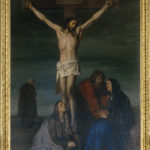Gebhardt’s painting

In Düsseldorf in 1866, Eduard von Gebhardt, who came from Järva-Jaani, completed the altar painting Christ on the Cross, which had been commissioned for Tallinn’s cathedral. The painting’s arrival in Estonia was an important event: prior to being installed on the retable, it was displayed in the Provincial Museum of Estland and, as is stated in the cathedral’s chronicle, the picture brought joy to many visitors, who returned time and again to experience the reverence that it conveyed. However, others criticised the painting’s realism. The painting Christ on the Cross was a sensation because nothing of the kind had ever been seen in Estonian churches before: its psychological quality and the placement of a biblical event in the artist’s contemporary time were novel. Christ’s cross on the Hill of Calvary is low and Christ on the cross is only about twenty centimetres higher than those who have approached the cross, so that Mary Magdalene kneeling at the foot of the cross can press her face against Christ’s calf. Christ is not agonising on the cross nor does he turn his gaze towards his heavenly Father, but rather he looks at his mother beneath the cross. Christ tranquilly bids his mother farewell, leaving her in the care of St. John. The Virgin Mary is depicted in an unprecedented way, not only as being older, as would befit the mother of the thirty-three year old Redeemer, but also as a wise, spiritually and physically strong woman. She does not faint beneath the cross but rather converses with her son, the higher meaning of whose earthly death she comprehends.
- Photograph: Peeter Säre
